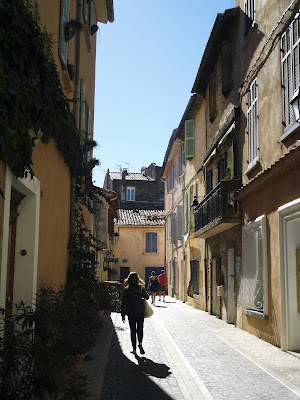I have been struggling, Gentle Reader, with how to describe our day in Fez in some succinct manner. it is a sensual city-- by which I mean it is full of sights, sounds, textures, smells, all unfamiliar and crowding on your senses like the crowds in the narrow streets. It is like stepping back into the middle ages, and like grieving the loss of a civilization. It is just so many things, and I experienced them all in a rather dazed state of mind!
The village streets in France were narrow, but nothing could prepare us for the medina (the old city). We followed a guide all day through her twists and turns (the man you may see in the blue robe ahead in some photos). This city was made the royal seat of Morocco in 802 or so, and is still a site of pilgrimage for Muslims because of its fine mosques and shrines. Now, it is a source of handiworks, a place called home by the poorest of the poor, by those doing 'urban renewal" and turning old homes into guest houses, and UNESCO folks who are shoring it up against collapse as a World Heritage Site. We spent 7 hours wandering the maze of streets. The next 6 photos give you sampling of streets from the largest and busiest to some of the smallest.
Our guide, was a retired political philosophy professor, who dished up a fair dose of Marxist political philosophy with his history, and made for an interesting day.
He explained that every quartier (or neighborhood) in the old city had five things:
1. a gate that could close for security of the neighborhood, though most gates are gone and only posts are left.
2. A fountain that provided drinking water and washing water
3. A mosque
4. A nursery school-- often with smaller doors for the children
And 5. a communal oven for baking bread
We toured the tanneries, a restored caravan house where caravans crossing north Africa would weigh and sell their wares, and a madersa, where university students lived. (Our guide made the distinction that these were not schools of Islamic stuidies, but full university residences. You did, however, have to ahve most of the Q'uran memorized to be able to attend the university.)
We saw a taxi stand. There are no motorized vehicles allowed within the walls of the medina, so donkeys do the work of carrying.
We took a taxi to overlook the city, and heard the late afternoon calls to prayer all rising from the valley in an eerie cacophony, and then entered through Bab Boujaloud, the famous gate.
This barely scratches the surface of this amazing city! The textures, sounds, and taste of mint tea with remain with me always.






















































